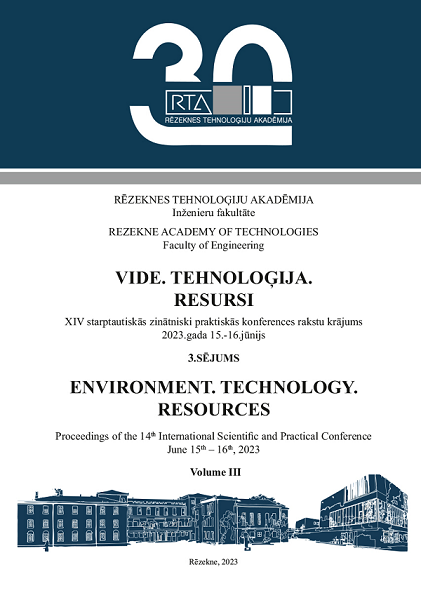INFLUENCE OF NI AS MINORITY ALLOYING ELEMENT ON THE CORROSION BEHAVIOR OF AMORPHOUS AL-CU-MG ALLOYS IN CHLORIDE SOLUTION
DOI:
https://doi.org/10.17770/etr2023vol3.7201Keywords:
amorphous alloy, aluminum, nickel, copper, magnesium, corrosionAbstract
The influence of nickel as minority alloying element on the corrosion behavior of amorphous alloys (Al74Cu16Mg10)99Ni, (Al74Cu16Mg10)98Ni2 and (Al74Cu16Mg10)97Ni3 was investigated. The amorphous alloys were obtained as ribbons by Chill Block Melt Spinning (CBMS). The amorphous structure of the alloys was proven by X-ray diffraction (XRD) and transmission electron microscopy (TEM). The corrosion rate was calculated gravimetric using continuous immersion tests for 360 hours in 3.5% NaCl solution at a temperature of 25oC. The lowest corrosion rate was found in the alloy containing 3 at. % Ni. The chemical composition of the accumulated corrosion products was studied using XRD.
The influence of nickel on the local corrosion resistance of the amorphous ribbons of (Al74Cu16Mg10)100-хNiх x = 0, 1, 2, 3% alloys was investigated electrochemically in a solution of 3.5% NaCl at 25°C. Pitting potential (Epitt) and repassivation potential (Erp) were determined. It was found that most resistant to pitting corrosion was the (Al74Cu16Mg10)97Ni3 alloy, which showed the noblest pitting potential (Epitt -0.332 V) and repassivation potential (Erp -0.530 V).
All obtained corrosion test results of the nickel-containing amorphous alloys were compared to the base amorphous Al74Cu16Mg10 alloy.
References
M. Naka, K. Hashimoto, T. Masumoto, J. Japan Inst. Metals, vol. 38, pp.835-841, 1974.
T. Aburada, N. Uёnluё, J.M. Fitz-Gerald, G.J. Shiflet and J.R. Scully, “Effect of Ni as a minority alloying element on the corrosion behavior in Al–Cu–Mg–(Ni) metallic glasses,” Scripta Materialia, vol.58, pp. 623–626, 2008, https://doi.org/10.1016/j.scriptamat.2007.11.041
S. Dhasneem, S. S. Farhana, S. Rajendran, T. Umasankareswari, S. Shanmugapriya, D. Renita, “Corrosion resitance of metallic glasses”, International journal of nano corrosion science and engineering, vol. 3, no. 1, pp. 48-59, 2016.
A. Kukuła-Кurzyniec, J. Dutkiewicz, P. Ochin, L. Perriere, P. Dłuzewski, A. Góral, “Аmorphous - nanocrystalline melt spun Al-Si-Ni based alloys modified with Cu and Zr,” Archives of Metallurgy and Materials, vol. 58, no.2, pp. 419-423, 2013, DOI: 10.2478/amm-2013-0010.
Y.Q. Cheng, E. Ma, ‘Atomic-level structure and structure–property relationship in metallic glasses,” Progress in Materials Science, vol. 56, pp. 379–473, doi:10.1016/j.pmatsci.2010.12.002.
Turnary Al-Cu-Mg diagram MSIT Workplace, https://www.msiport.com/msi-research/ternary-evaluations/notes-for-authors-pdf/, ID:10.12587(2003).
M. Gögebakan, O. Uzun, T. Karaaslan, M. Keskin, “Rapidly solidified Al–6.5 wt. % Ni alloy”, Journal of Materials Processing Technology, vol. 142, no.1, pp. 87-92,2003,https://www.sciencedirect.com/science/article/abs/pii/S0924013603004667.
V. Dyakova, G. Stefanov, I. Penkov, D. Kovacheva, N. Marinkov , Y. Mourdjeva, S. Gyurov, “Influence of Zn on glass forming ability and crystallization behaviour of rapidly solidified Al-Cu-Mg (Zn) alloys”, Journal of Chemical Technology and Metallurgy, vol. 57, no. 3, pp. 622-630, 2022, https://dl.uctm.edu/journal/node/j2022-3/23_21-64_br_3_pp_622-630.pdf.
V. Dyakova, Y. Mourdjeva, N. Marinkov, G. Stefanov, Y. Kostova, S. Gyurov, “Effect of Ni as minority alloying element on glass forming ability and crystallization behavior of rapidly solidified Al-Cu-Mg-Ni ribbons”, Journal of Chemical Technology and Metallurgy - in print.
G. S. Frankel, M. A. Russak, C.V. Jahnes, M. Mirzamaani, V.A. Brusic, “Pitting of Sputtered Aluminum Alloy Thin Films”, J. Electrochem. Soc., vol. 136, no. 4, pp.1243-1244, 1989, DOI: https:// doi.org/10.1149/1.2096864.
S. Harshmeet, “The corrosion behaviour of aluminium alloy b206 in seawater”, M.S. thesis, University of British Columbia, Vancouver, 2016.
R. Orozco, J. Genesca, J.Juarez-Islas, “Effect of Mg Content on the Performance of Al-Zn-Mg Sacrificial Anodes”, ASM Internat. JMEPEG, no. 16, p. 229–235, 2007, DOI:10.1007/s11665-007-9037-z.
V. Dyakova, Y. Kostova, S. Gyurov, D. Kichukova, H. Spasova, “The influence of Zn on the corrosion behaviour of amorphous and nanosized rapidly solidified (Al75Cu17Mg8)100-хZnx alloys and their crystalline analogues”, Mater. Sci. Non-Equilibr. Phase Transform., vol. 6. no.3, pp. 73-76, 2020, https://stumejournals.com/journals/ms/2020/3/73.full.pdf
V. L. Dyakova, Y. G. Kostova, B. R. Tzaneva, “Effect of minority alloying elements Zn and Zr on the corrosion behavior of amorphous alloys AlCuMg(Zn) and AlCuMg(Zr) and their nanocrystallineanalogues,” ChemChemTech, vol. 65, no. 4, pp. 62-70, 2022, DOI: https://doi.org/10.6060/ivkkt.20226504.6550.
K. Dževad, K. Kozlica, J. Ekar, J. Kovač, and I. Milošev, ‘Roles of chloride ions in the formation of corrosion protective films on copper,“ Journal of The Electrochemical Society, vol.168, p. 031504, 2021, DOI:10.1149/1945-7111/ABE34A.



